
The coronavirus pandemic has made it complicated and costly to shoot videos. Consequently, many companies have now turned to the capabilities of artificial intelligence (AI) development to fulfill their communication needs.
Thanks to COVID-19, Deepfakes Have Gone Corporate
Earlier this month, major advertising corporation WPP sent new training videos to thousands of its employees across the world. For each one, the presenter explains basic AI concepts to the recipient in their preferred language and even addresses them by name. The videos themselves are actually profound demonstrations of what’s possible with AI — the presenter’s facial motions and speech are all fabricated by software.
Welcome to the new era of deepfakes. These AI-generated images or videos that appear uncannily real have caused their fair share of controversy in the past by being used for pornography, harassment, or deceit. Today, companies are tapping into their potential for purposes such as corporate training.
WPP’s AI-fueled training videos are made possible through technology from a London-based development startup known as Synthesia. While impressive, they’ve still got some way to go from being perfect. Stephan Pretorius, WPP’s CTO, admits that the presenters’ speech patterns can be off. But it’s undeniable that these personalized products make for more compelling features than the typical corporate training material.
Production of deepfakes can be quick and cost-effective. And since COVID-19 restrictions have made conventional video shooting tricky and risky, these benefits have only been magnified. To put this in perspective, Pretorius says that a similar company education campaign under normal circumstances may require 20 different scripts to address WPP’s worldwide workforce. Each video would cost tens of thousands of dollars to create. Thanks to Synthesia’s technology, such an endeavor has been pared down to one lump sum of around $100,000. Currently,
Changing Faces With Just a Few Clicks
Leveraging machine learning and AI, several startups are now crafting deepfake videos and images as substitutes for conventional marketing campaigns and internal corporate communication. This isn’t surprising when you consider that synthetic media has become more mainstream. For instance, renowned talent agency CAA recently signed a computer-generated social media influencer known as Lil Miquela. She has more than 2 million followers.
Rosebud AI specializes in creating virtual media for e-commerce or marketing purposes. The company made headlines last year when it released 25,000 modeling photos of people who never existed, as well as tools to swap the synthetic faces into any image. Recently, it launched a new service that lets you place clothes photographed on mannequins onto its synthetic models.
Lisha Li is the CEO and Founder of Rosebud AI. She believes that Rosebud is lowering the barrier for small brands to produce compelling image portfolios. Before, an enormous creative team and the purchase of stock photos were required to achieve this. Now, all you need to do is tap into the power of algorithms.
Are Deepfakes the Future of Images and Videos?
Besides WPP, Synthesia has also helped concoct deepfake videos for big clients such as SAP and Accenture. Just last year, it helped David Beckham launch a malaria PSA in 9 different languages. Victor Riparbelli is the company’s CEO and Co-Founder. He thinks that more widespread use of synthetic video is inevitable. And judging from the surge in demand of Synthesia’s technology during the COVID-19 pandemic, he seems to be right.
Synthesia’s tools enable you to make a video in seconds. You simply select an avatar, type out the script, and click the “Generate video” button. The avatars are based on real people; they receive royalties based on how much footage they appear in.

Basically, Synthesia’s algorithms digest real video of the model. Then it learns how to generate new video frames that match the model’s facial movements to a synthesized voice’s words. This capability is available in more than 24 languages. Alternatively, customers can choose to create their own avatars.
While deepfakes may seem inevitable, Riparbelli and others involved with their commercialization are approaching the future with caution. Not only has Synthesia posted ethics rules to its site, but it also vets customers and their scripts. It doesn’t do anything related to politics, and any model used as an avatar must formally consent first.
Li strongly believes that Rosebud’s technology should produce more good than bad. Besides helping smaller companies compete, she says that the capabilities offered by Rosebud and similar companies should broaden humanity’s beauty standards. “A lot of the users I am working with are minority brand owners who want to create diverse imagery to represent their user base,” Li explains.

Subbarao Kambhampati, an Arizona State University AI professor, admits that this technology is impressive. But he also wonders if the usage of diverse, synthetic models could decrease the work available for their human counterparts.
As deepfakes move more into the mainstream, it’s clear that large corporations and big brands will shape how the general public experiences the technology. Hopefully, all involved adhere to ethical standards. It’s the only way to ensure that this new paradigm of marketing and storytelling heads in the right direction.
What do you think of deepfake technology? Do you think it presents more dangers than advantages? As always, let us know your thoughts in the comments below!





